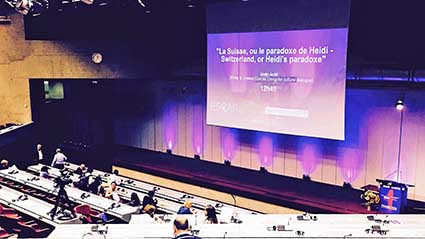Prof. Eliez tells us more about last July ESCAP 17th Congress
19 September 2017

The seventeenth International Congress of the European Society for Child and Adolescent Psychiatry (ESCAP) — with “transition” as its central theme — was held in Geneva in July 2017 with nearly 1,400 psychiatrists in attendance. The congress received substantial backing from Synapsy.
Synapsy looks back on this year’s congress with Stephan Eliez, ESCAP president.
What does “transition” refer to in child psychiatry?
It can be broken down into several levels. The first is the patient’s transition through the various stages of care linked to their development: the organisation of care as they pass from childhood to adolescence and on from adolescence to adulthood. This last transition is an immense challenge. In childhood, care is provided in a specialised and relatively “containing” environment, where interactions with the family play a central part. In adult psychiatry, care is provided in a less containing environment, such as a hospital, and is addressed directly to the patient. This means that relatives don’t have the same bridging role. What’s more, for teenagers, everything is about the future and potential. When they switch to adult care, they come face-to-face with patients whose lives, it seems, are very much influenced by the disorder they are suffering from. The outlook is not the same any more.
Another huge challenge for child psychiatry is the transition from the world of care to education. Not every country (and not even the Swiss cantons) is like Geneva, where care is embedded in state education. This is an exceptional situation, and it makes a great deal of flexibility. Elsewhere, the two universes are split, and caregivers are not always able to support young patients in their principal environment, which is school.
Lastly, there is also the transition facing traditional psychotherapeutic models, which are now bound to incorporate neuroscience. So, it’s a transition with a strong identity, and there’s the danger of losing the good things rooted in humanistic psychotherapeutic relationships. This is an issue that goes to the heart of Synapsy’s legitimacy: bringing psychiatry and child psychiatry closer to neuroscience with the idea of building bridges between them, and so that we can produce a new generation of psychiatrists. This new breed is embodied in the psychiatrists who have undertaken research PhDs thanks to projects and funds laid on by Synapsy.
The attendees were largely satisfied with the meeting, according to the ESCAP surveys, but they would like to have more clinical content. Is this a sign that the transition to neuroscience isn’t complete yet?
No, I wouldn’t say that. ESCAP is deliberately designed as a congress for general clinicians, so the audience wants something concrete. It is looking for things that can be put into practice straightway in treating their patients. Epidemiological or evidence-based studies provide guidance on diagnoses, criteria, risks or the development of a particular pathology — but they don’t say anything about what to do. Although there is an enormous amount of research in child psychiatry, the part devoted to studies on intervention effectiveness is very small. For example, with the exception of pharmacology, there are few comparative studies on the various types of intervention. These clinical studies are very expensive, and take up a lot of time and energy. Even then, they are difficult to publish, which explains why they are so rare.
Synapsy sponsored eleven symposia during the congress. How is its involvement important for ESCAP and vice-versa?
Synapsy’s mission is to introduce neuroscience into the psychiatric community. As part of this approach, Synapsy takes steps to communicate effectively on a nationwide basis. Having its name attached to eleven symposia has made Synapsy very visible, especially when you consider that three-quarters of Switzerland’s child psychiatrists were present at the congress —about 700 people.
Synapsy is involved in very specific research topics, such as autism and 22q11 syndrome. There were a lot of participants in these two areas, without doubt because the Synapsy cohorts are really well known in Switzerland. This is particularly the case with Marie Schaer‘s early intervention in autism. Synapsy is something of the missing link in this research because all the tools needed for neurosciences, epigenetics, EEG and eye tracking are applied here.
Synapsy’s involvement has also raised the visibility of clinically-oriented neuroscience in the European child psychiatry community. This is a significant contribution to ESCAP, where the community has an average age of 45 to 50 —a generation of psychiatrists who have not been systematically exposed to neuroscience. Given the biological aspect of psychiatry when treating mental disorders, it’s important that it is brought face-to-face with psychiatry.
Interview by Yann Bernardinelli – August 2017
